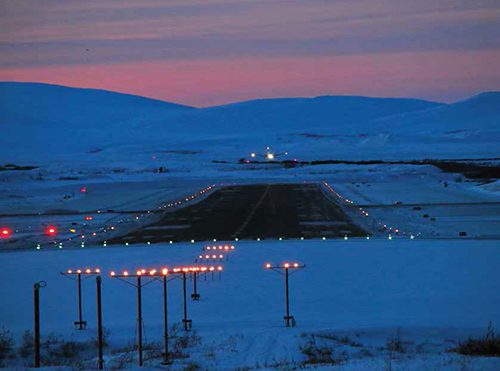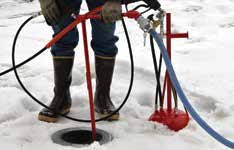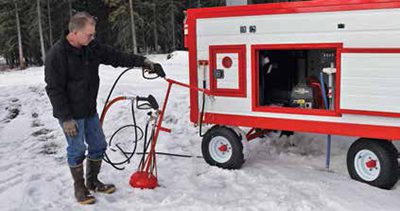Airfield maintenance can be tough at any location, but few places in North America present more challenges than northern Alaska. Keeping runway and taxiway lights working at the remote airfields that dot the state can be extremely challenging, and workers who undertake the job often work in downright punishing conditions.
One of the state officials who supervises such operations is Steve Meierotto, regional buildings maintenance manager with the Alaska Department of Transportation and Public Facilities. He is in charge of 415 buildings in the state’s Northern Region, which encompasses 67 rural airports.
“This is a huge territory to cover-it’s larger than the state of Texas,” Meierotto explains, noting that some villages are 650 miles from the department’s base in Fairbanks.
 FACTS&FIGURES FACTS&FIGURESProject: Maintaining Airfield Lights Location: Alaska Northern Region Airports: 67 Territory Size: Larger than state of Texas Airfield Buildings: 415 Associated Maintenance Staff: 47, including 3 electricians Primary Task: Maintaining airfield lights Regional Challenges: Ice buildup in light canisters; brutal weather for maintenance personnel; airfield vandalism; wildlife damage; varying efficiency of local contractors New Maintenance Equipment: ThawHead & ThawRig Vendor: Central Alaska Metalworks Equipment Benefits: Reduced maintenance time (from 2 hours to 10-15 minutes); reduced cost for wait time by outside pilots who fly in maintenance crews |
“Our climate is brutal,” he continues. “If it is colder than -20° F, we usually do not go out. That is also the limit for the leased aircraft we use to reach the remote airfields. Commercial flights, however, sometimes will fly at -30°F and colder.”
With only three electricians on his 46-person staff, repairing lights is typically one of Meierotto’s biggest challenges.
Even at the smallest and most remote airports in northern Alaska, regulators for airfield lighting are housed in electrical equipment buildings. Each field’s lighting system is connected to a specific radio frequency, so approaching pilots can turn on runway and taxiway lights by clicking their microphones inside the cockpit.
Same Specs, Different Strategies
FAA specifications for runway lights in Alaska are no different from those used at other airports in the United States and Canada. Each light is mounted and sealed atop a 14-inch-diameter, 2-foot-deep steel canister. When canisters in Alaska are damaged, however, they quickly fill up with snow, water and gravel. Soon, the transformer and airport circuit wires become encased in ice. Amid Alaska’s characteristically cold temperatures, ice is an extremely tough material. To make repairs, maintenance personnel often chip away at icy globs with hammers, chisels and screwdrivers. Clearing ice from canisters can take a long time-up to two hours per light in subzero temperatures-and crews often inadvertently damage transformers and wiring during the rough and inexact process.
Although the canisters that hold airfield lights are sturdy, the area’s harsh climate often damages them, notes Meierotto. “At most of our airports, the ground is saturated and subject to frost cycles of freezing and thawing,” he explains. “The canisters are open on the bottom. If there is a big rain, water comes up from the bottom, and the canisters can freeze and pop like frozen soda cans. This jacks up the can, and can tear up the electrical connections and break the circuit, taking out all the airport lights.”
Canisters that pop up because of frozen water also are much more likely to be hit by snowplows, he adds.
At most North American airports, runway and taxiway lights are flush-mounted even with the ground. In northern Alaska, though, they reside 2 feet above runway and taxiway surfaces. “All of ours are stalk-mounted, with breakaway capability for safety,” specifies Meierotto. “If the light breaks off, then a replacement can be installed simply. The maintenance guy only has to unbolt the top of the can.”
Even with a full-time pilot on staff, weather and a limited number of electricians make it difficult to reach every airport quickly. Meierotto relies on a local contractor based at each airfield to perform daily runway inspections.
Tyler Connell, who is based in the state’s Fairbanks office with Meierotto, also works closely with local contractors. Only two of the 20 airfields Connell manages have paved runways. The rest are gravel-often 4,000 feet long and 100 feet wide, with 20 lights on each side. Taxiways have three to four lights on each side. (By FAA regulations, edge lights cannot be more than 200 feet apart.)
“From October to April, the local contractor checks lights every day; it is part of their contract,” Connell explains. The state stocks each airport with supplies such as bulbs, stalks, lenses, frangible coupling, etc. Local operators make simple repairs, such as changing bulbs. “There are up to 20 pieces for each light,” notes Connell.
When lights need to be fixed, he and his crews have learned the hard way that chipping away ice inside canisters is often not worth the effort. “You are more likely to wreck the transformer,” he comments. “In the past, we have set up fishing shacks over a light, with space heaters. That helps warm the workers, but it doesn’t work so well to thaw out the can.”

Often, Connell and his fellow operators have to stay overnight at remote airports. “We have contingency shelters at some of the airports, with heat, electricity and a microwave. There aren’t any hotels,” he says. At airfields without contingency shelters, crews sleep in the snow removal equipment building or electrical equipment building-structures available at all state-managed airfields in Alaska.
“In some situations, when our workers get off a plane and have a long day ahead of them, the plane will just take off, and come back later to retrieve them,” says Meierotto. “Other times, the pilot will just wait until they are finished. Once they deplane, the operators will often pack a sled with gear, and tow it up and down the runway trying to locate the cause of the lighting failure. It is pretty wicked duty. If it is way below zero, they may be able to spend only a short time out on the runway before they have to go into one of the heated buildings just to warm up.”
 According to Connell, airfield lights at Alaskan airports are more apt to get hit by snowplows than to burn out. Other serious problems occur when ground shifts, due to expansion and contraction of the permafrost. Sometimes, shifting ground severs the main lighting circuit serving an entire airport, and all the lights go dark-an obviously high-priority problem.
According to Connell, airfield lights at Alaskan airports are more apt to get hit by snowplows than to burn out. Other serious problems occur when ground shifts, due to expansion and contraction of the permafrost. Sometimes, shifting ground severs the main lighting circuit serving an entire airport, and all the lights go dark-an obviously high-priority problem.
“If there are more than four in a row burned out, we have to shut down the airport. If too many lights are out, the regulator won’t work, and all the lights go dark,” Connell says.
Local contractors are expected to replace bulbs and complete relatively simple maintenance. But for more complicated electrical work, someone from Meierotto’s staff flies in to perform the work. “We do not want the local guys to do complicated electrical work, for their personal safety,” he explains, noting that a main lighting circuit contains up to 2,000 volts.
 When a local contractor reports that lights are out and can’t be repaired simply, the state dispatches one of its maintenance employees to begin the painstaking task of removing ice and gravel from the can before completing electrical repairs. Previously, crews used a rotor hammer with a custom-made bit and scraped ice out by hand to reach wiring in need of repair. “In the past, we have tried anything you can imagine to repair lights,” Meierotto recalls.
When a local contractor reports that lights are out and can’t be repaired simply, the state dispatches one of its maintenance employees to begin the painstaking task of removing ice and gravel from the can before completing electrical repairs. Previously, crews used a rotor hammer with a custom-made bit and scraped ice out by hand to reach wiring in need of repair. “In the past, we have tried anything you can imagine to repair lights,” Meierotto recalls.
New Ice Tool
Fortunately, the nastiest part of performing electrical repairs at Alaskan airfields may soon be a thing of the past. A new portable system allows crews to thaw ice inside lighting canisters and remove the meltwater and accumulated debris to expose the area or container needing repair work. (See sidebar on Page 28 for more information.)
“These products have made a huge difference for us,” Meierotto reports, noting that the state purchased two sets of the new equipment. One is kept in Fairbanks, and the other is based in Nome.
 “We can fly them to our airports and do repair work in a much shorter period of time,” he adds. At $12,000 per thawing/extraction unit and $42,000 for each support rig, Meierotto acknowledges that the products are expensive, but notes that the equipment will save the state money previously spent on outside pilots. “They are paid on an hourly basis, and we sometimes had to pay them for several hours while they sat on the ground at an airport while our guys spent all day fixing lights,” he explains.
“We can fly them to our airports and do repair work in a much shorter period of time,” he adds. At $12,000 per thawing/extraction unit and $42,000 for each support rig, Meierotto acknowledges that the products are expensive, but notes that the equipment will save the state money previously spent on outside pilots. “They are paid on an hourly basis, and we sometimes had to pay them for several hours while they sat on the ground at an airport while our guys spent all day fixing lights,” he explains.
Connell agrees that the state’s new equipment makes airfield lighting repairs faster and easier. “We can land at an airfield and get all the lights fixed in a couple of hours, instead of two days,” he specifies. “The Sherpa cargo planes we use have ramps in the back, and you just drive the [customized trailer] from the plane to the ground, and get going.”
At Meierotto’s request, the system’s inventor gives demonstrations to operators in the maintenance department on how to use the equipment. “We want everybody on our staff to eventually know how to use it,” Meierotto says.
Ice Isn’t the Only Problem
Mother Nature isn’t the only local presence that complicates airfield maintenance in Alaska. “We sometimes have problems with vandalism at our airports,” Meierotto acknowledges. “Somebody apparently gets bored, and will run along the runway with a snowmobile or all-terrain vehicle and a baseball bat, breaking runway lights. When this happens, it overloads the lighting regulator and circuit, and all the lights will shut off.”
Many of the state-owned snow removal equipment buildings have bullet holes in them, and airport beacons, runway lights and wind cones have also been used for target practice, he adds.
 Sometimes, the local contractors hired for help with basic airfield maintenance prove to be part of the problem rather than the solution. “As with any group of people, some of these contractors are great, most are good, and some are unreliable,” Meierotto explains. “If a village only has 30 residents, and someone wants to be our contractor, the primary qualification is low bid. That is it. In some cases, there is only one bidder.”
Sometimes, the local contractors hired for help with basic airfield maintenance prove to be part of the problem rather than the solution. “As with any group of people, some of these contractors are great, most are good, and some are unreliable,” Meierotto explains. “If a village only has 30 residents, and someone wants to be our contractor, the primary qualification is low bid. That is it. In some cases, there is only one bidder.”
In addition to changing bulbs and inspecting airfield lights, local contractors also use the department’s equipment to clear snow from runways. “We’ve had cases where the new contractor’s first experience in heavy equipment is immediately after they sign the contract and get the airport keys,” relates Meierotto.
Wildlife damage is another common challenge at Alaskan airfields. At Shageluk Airport, wood bison were breaking off runway lights when using them as “belly rubs.” Caribou and bears are repeat offenders elsewhere.
Keeping airfields open year-round in the state’s vast, undeveloped areas is a responsibility Meierotto and his colleagues take seriously. “Approximately 80% of the villages do not have roads, and the local airfields are the only way to get supplies in,” he explains. “If there is a medical emergency, it is imperative that planes be able to fly in to transport a local resident to a medical facility. Therefore, we have to keep the runway lights up and running.”
|
New Equipment Solves Cold-Weather Maintenance Problems Shortly after meeting with the two state officials, Gackstetter designed, built and tested a prototype of the ThawHead, a portable system that uses a two-stage process to thaw ice inside lighting canisters and allow crews to remove the meltwater and debris quickly and efficiently. Because the equipment is relatively light (less than 40 pounds) and compact (40 inches tall, 11 inches in diameter), it is especially practical for Alaska’s remote airports. In addition, the system uses hot water without any added chemicals, so it is considered to be environmentally friendly. After producing the ThawHead, Gackstetter went to work designing a trailer to support and transport his new product. The result, dubbed the ThawRig, is an insulated trailer that contains a pressure-washer, generator, water pump, electric heater, battery charger, polyethylene water tank, antifreeze storage tank and room for the ThawHead apparatus. The self-contained wagon generates its own heat and electricity, and is built to withstand high winds and temperatures down to -20°F, with features to minimize frozen water lines, and fuel capacity to facilitate four hours of operation. “If you have road access, you do not need the rig,” he notes. “The head will work with any high-pressure washer. For example, if you are in Bemidji, MN, and have road service to the airport, you can just put the ThawHead in a pickup truck, and drive right to the lights on the runway needing work, and be done in 30 minutes or so.” Gackstetter and his wife, Shannon, formed their own corporation, Central Alaska Metalworks, and have filed for product patents in the United States and Canada. ThawHead units cost $12,000 each, and individual ThawRigs cost $42,000. |




 Gackstetter specifically designed the ThawRig to be towed by snowmobiles and all-terrain vehicles, and the unit fits neatly inside the small cargo planes that are the lifeline of northern Alaska.
Gackstetter specifically designed the ThawRig to be towed by snowmobiles and all-terrain vehicles, and the unit fits neatly inside the small cargo planes that are the lifeline of northern Alaska.  So far, the company has sold two complete units (ThawHead and ThawRig) to the state of Alaska. Five more Thawheads are built and ready for market, with four more in production. Gackstetter hopes to sell them to airports and military bases in northern countries around the world.
So far, the company has sold two complete units (ThawHead and ThawRig) to the state of Alaska. Five more Thawheads are built and ready for market, with four more in production. Gackstetter hopes to sell them to airports and military bases in northern countries around the world.
